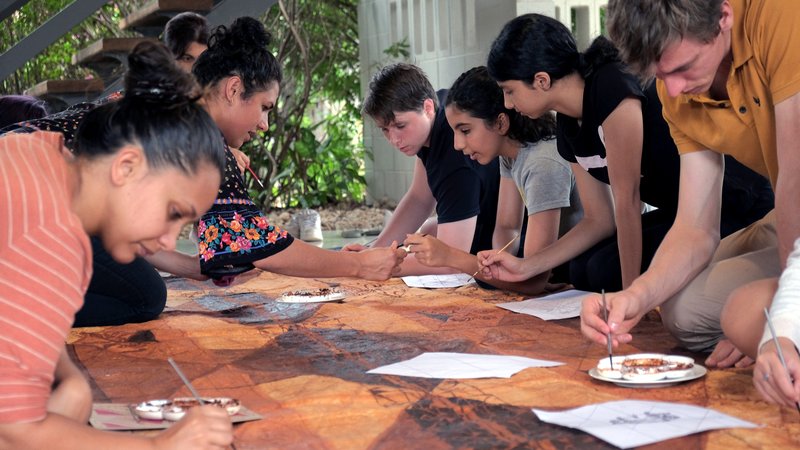Building Community: Guide to socially-engaged arts projects
Key to delivering beautiful and powerful community engaged projects are the recommended processes of relationship building explored in NAVA’s Code of Practice.
Key to delivering beautiful and powerful community engaged projects are the recommended processes of relationship building explored in NAVA’s Code of Practice.

Image: Ruha Fifita co-facilitating an Ivi Kato Kakala learning space with members of community in Cairns. Courtesy of photographer: Sheida Vazir-Zadeh.
ID: Photo of a mix of seven young people and adults kneeling over a collaborative artwork with paintbrushes.
Community engaged arts practices have the transformative power to activate solidarity and agency, facilitating social action and cultural democracy within communities. For a community engaged project to be successful, as well as culturally and physically safe, practitioners require knowledge of the key concepts, issues and processes of community building.
The newly added Community Engagement section in NAVA’s Code of Practice for Visual Arts, Craft and Design (the Code) presents recommended processes to help guide community engaged arts practices. Jointly written by Robyn Gawenda, former Executive Director and Co-CEO of Footscray Community Arts, and Daniel Santangeli, Artistic Director and current Co-CEO of Footscray Community Arts, this section explores practices that embed direct engagement and exchange between practitioners, organisations and communities within a project.
While not all community engaged projects are political in content or themes, they are often underpinned by social justice. The Code states that, ‘community engaged practitioners draw on their skills of professional arts practice to build cultural capacity, remove barriers to cultural representation or provide a platform to interrogate a community cause or issue.’
The Code’s Community Engagement section provides practitioners (including artists, individuals, organisations and institutions) with recommended processes for relationship building, establishing expectations and problem solving. The good practice guidance is formed around a series of questions that practitioners should ask themselves at the start, during and at the end of a project.
At the heart of community engaged practices (also referred to as community arts, community and cultural development and socially-engaged art) are meaningful relationships and self-determination from the community engaged. Practitioners are responsible for a project culture that fosters generative, safe and equitable relationships. Part of this relationship building process is practicing self-awareness and reflection and acknowledging the power differences that exist between artists and communities. ‘Nothing about us without us’ is a common mantra in the field, however the Code advises that practitioners ‘take the time to understand what this really means for the community you are engaging in a practical sense. This may include planning against tokenism, appropriation, and planning for employment targets and/or cultural safety.’
During the project conceptualisation phase, practitioners should consider the First Nations context of the project and respond in a way that is guided by First Nations voices. All parties must ensure that Indigenous Cultural and Intellectual Property (ICIP) principles are upheld and that First Nations peoples’ rights to their cultural heritage, traditional knowledge and traditional cultural expressions are respected and protected.
Projects will vary in terms of scale, cultural and societal context, and the goals and needs of the community members being engaged. The Code states it is therefore essential for practitioners to establish a social contract to ensure all participants, including any funding bodies, are clear on goals, motivations, outcomes and expectations of the project.
Furthermore, strong community engaged projects need to be resourced appropriately. Relationship building, self-education, building the cultural capacity of your organisation, and problem solving in a community context all take time, money and labour. Included in this Code section is guidance on when it is necessary to pay the community as collaborators, participants and consultants for your project.
Community engaged practices are interested in creating more collective approaches to artmaking that can catalyse profound transformations in society. Key to delivering beautiful and powerful community engaged projects are the recommended processes of relationship building explored in NAVA’s Code of Practice.